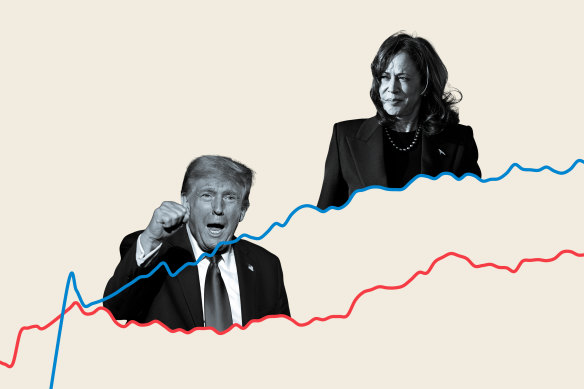This was published 9 months ago
Opinion
If the polls have underestimated Trump the same way again, he’s set for an easy victory
By Nate Cohn
With four weeks to go until the election, the race for the White House is as tight as it has been for the past two weeks.
The New York Times polling average shows Kamala Harris and Donald Trump essentially tied across the seven battleground states considered likeliest to decide the presidency, with neither ahead by enough to count as even a modest favourite.

The race for the White House is as tight as it’s been for the past two weeks.Credit: Stephen Kiprillis
In state after state, the average is essentially unchanged after a newsy week that included the vice presidential debate, the new jobs report and Israel’s assassination of Hezbollah’s leader.
In today’s polarised country, it’s not necessarily surprising when the news doesn’t affect the numbers. This week, though, there was a different reason the polls didn’t seem to budge at all: there just weren’t many of them.
Even if these developments did affect the race, there probably hasn’t been an opportunity for the polls to show it.
Where are the polls?
In recent cycles, the first week of October has usually been a busy one for polling, sometimes featuring dozens of high-quality polls. This week there were only a handful.
Surprisingly, there wasn’t a single new poll released for a morning news show on Sunday. There wasn’t a single poll released for a Sunday paper anywhere in the United States, either.
Why are there fewer polls? The most important reason: money. High-quality polling has become far more expensive in recent years, just as many of the traditional media sponsors of public polling find themselves struggling financially. Put it together, and the number of polls has plummeted.
Another factor: the polls face legitimate questions about their reliability following the 2016 and 2020 elections. It’s harder to fork out the big bucks for what can be an untrustworthy product.
The declining number of high-quality polls has led to unusual polling surges and droughts over the past few months. The organisations sponsoring or conducting polls have similar interests and incentives, and they seem to be making similar decisions about how to best use their scarce resources. They might each decide, for instance, that they want a poll immediately before the election, before or after a debate, or around the conventions. As a result, it can seem as if all the major pollsters conduct polls around the same time – like when a dozen pollsters weighed in on Pennsylvania after the first debate – only to then go dark.
Most pollsters apparently decided that last week was a natural moment to pause. If you put yourself in their shoes, it’s easy to see why. Almost every pollster decided to field a post-debate poll two weeks ago. They will probably conduct a poll again at some point before the election, of course, but with those two surveys locked in, it may have been hard to justify a third survey last week – less than halfway between the debate and the election. The resources for that hypothetical third poll might just be better spent on an additional poll in another key state near the finish.
The New York Times didn’t release any polls last week, either. Its calculation was similar: having polled the nation and the key states after the debate, it felt it was a touch too soon to poll them again.
What if the polls are wrong?
Of course, even if there had been many new polls this week, it’s hard to believe they would have shown much new and different.
After all, the polls have been remarkably stable over the past month or so since Harris successfully reunified her party after becoming the Democratic nominee.
This stability can be a little deceiving. It might give the impression that her narrow edge in Pennsylvania, for instance, is pretty solid: she has led in that state in our average for more than a month.
The durability of Harris’ tiny edge in Pennsylvania polling, however, doesn’t make her any likelier to win the state. The poll average could even be so stable in part because many pollsters are using heavy-handed statistical techniques that reduce the variance of their results from poll to poll but that increase the risk of systematic errors. Systematic polling errors – in which one side does better than expected, across the board – have been common in recent cycles.
In 2016 and 2020, the polls underestimated Trump just about everywhere. If it happened again this cycle, he would claim an easy victory. On the other hand, the 2022 polls underestimated Democrats in most key states. If it happened again, it would be Harris who claimed a victory.
Unfortunately, there’s no great way to tell in advance which way the polls will err.
The only thing that’s clear: the polls are so close that neither candidate has a meaningful advantage.
This article originally appeared in The New York Times.
In the lead-up to the US election we will be sending a special Harris v Trump edition of our What in the World newsletter every Tuesday. Sign up to get the whole newsletter delivered to your inbox.